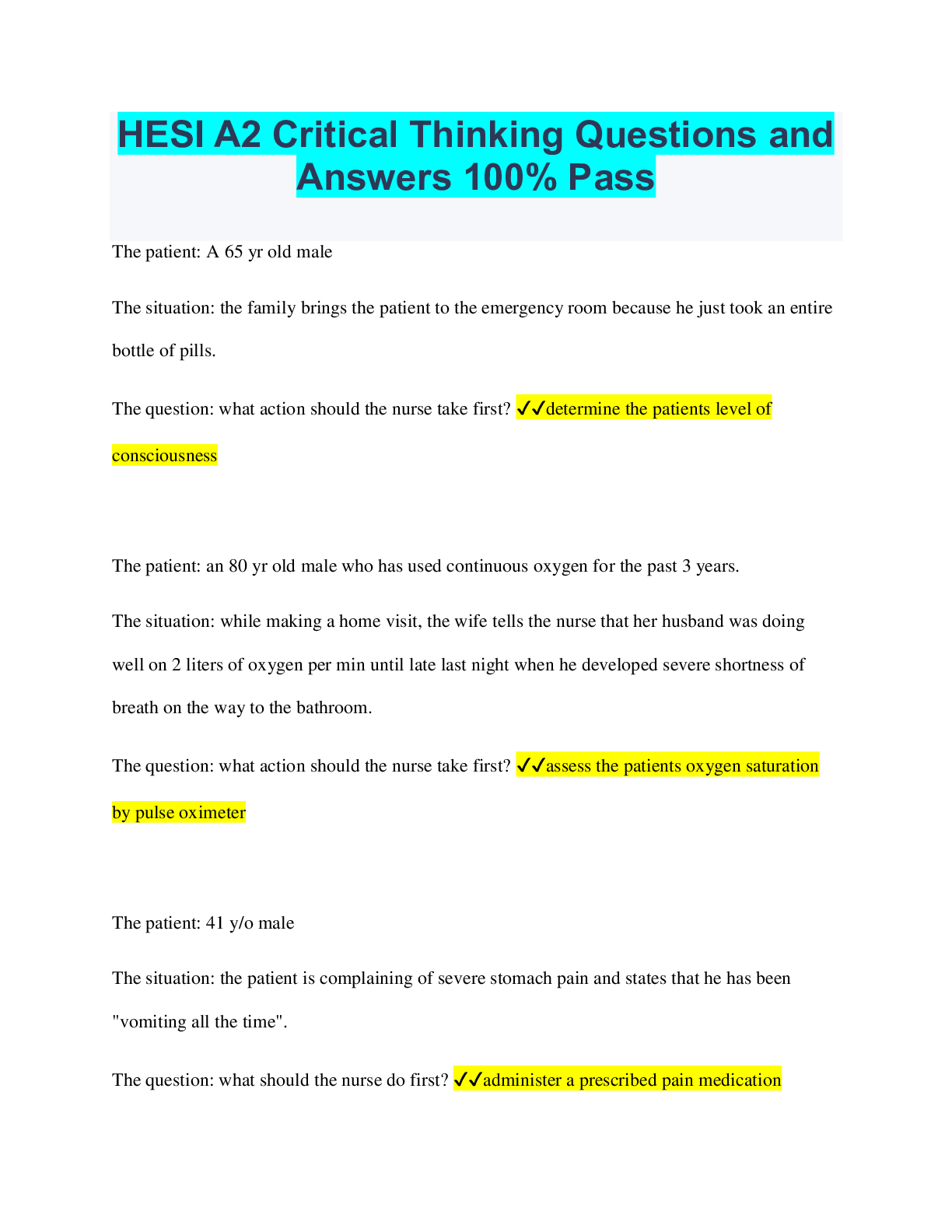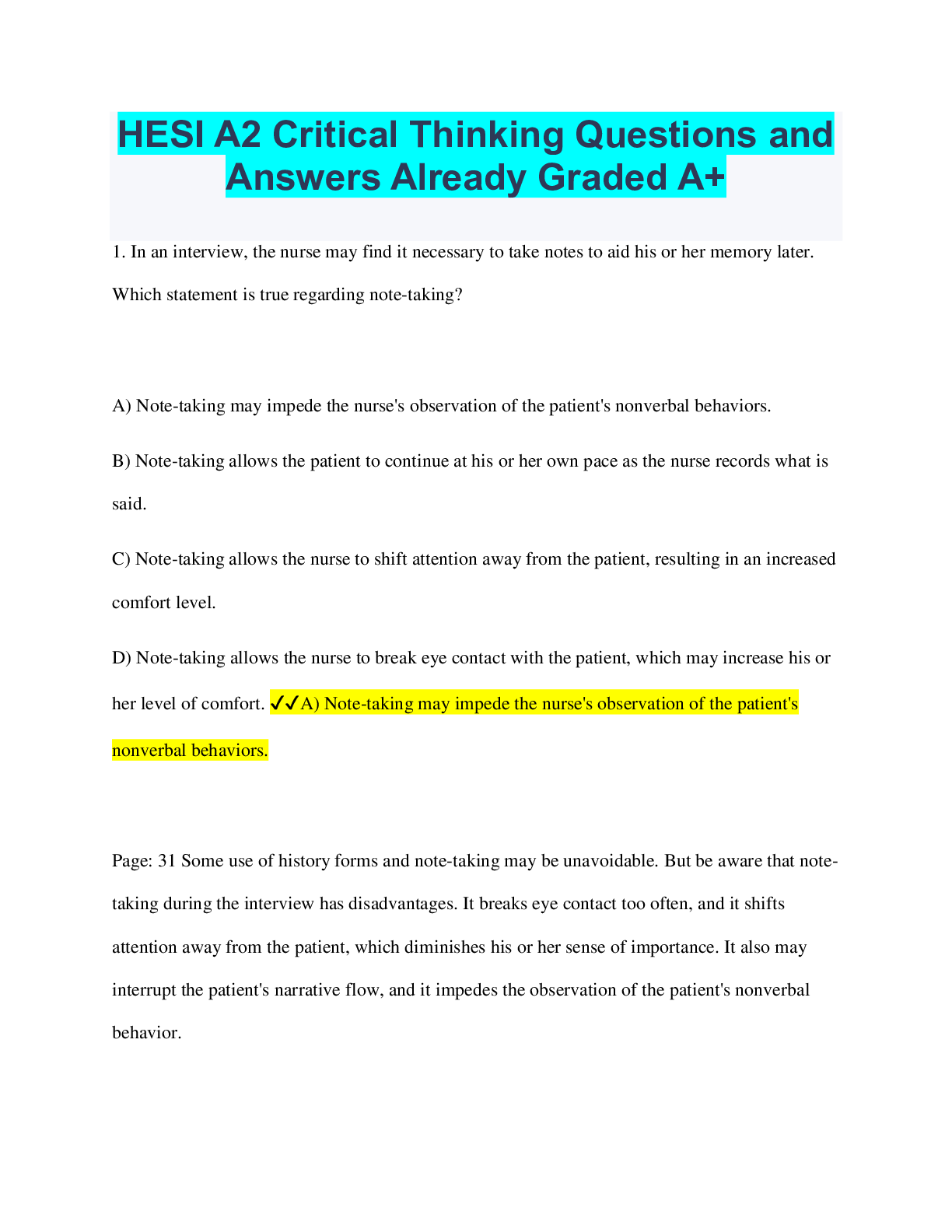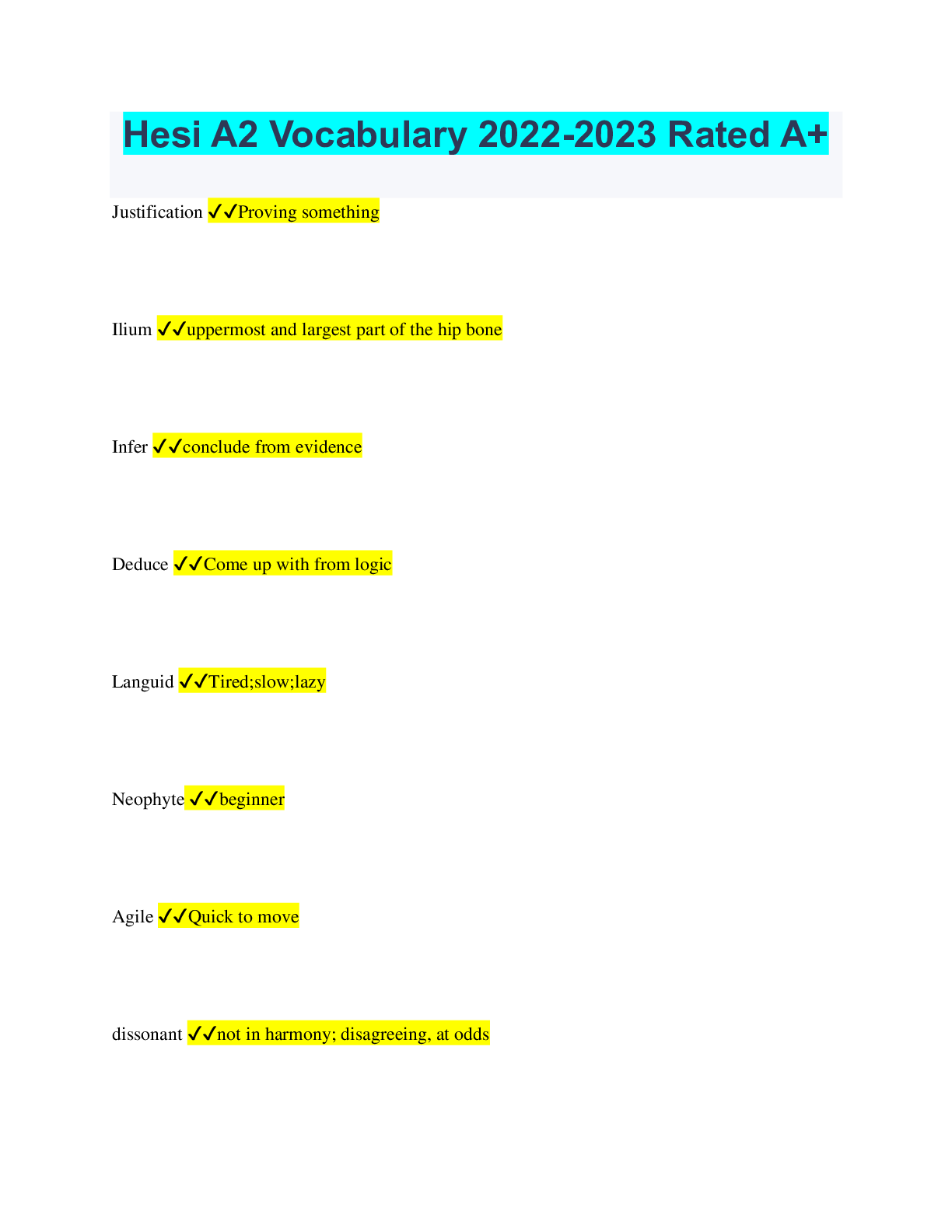*NURSING > QUESTIONS & ANSWERS > RN Maternal Newborn Final:QUESTIONS AND ANSWERS,100% CORRECT (All)
RN Maternal Newborn Final:QUESTIONS AND ANSWERS,100% CORRECT
Document Content and Description Below
ATI Maternal Newborn Final: A nurse is caring for four newborns. The finding the nurse should report to the provider is: - A 12-hr newborn who has a HR of 70/min while sleeping. Rationale: The ... average HR for a newborn is 80-100/min while sleeping. May increase to 180/min during ep. Of crying. A nurse is contributing to the plan of care for a client who plans to formula feed her newborn. The ff action the nurse should include in the plan is to: - Have the client place ice packs on her breast four times/day. Rationale: Engorgement can occur in the non-breastfeeding client. It is uncomfortable, & occasionally painful. Ice application to the breast for 15-20 min, QID for 5 days, avoiding breast stimulation & keeping warm water off the breast during showering are effective methods to reduce milk production & suppress lactation. A nurse is caring for a client who is at 34 wks gestation & has prescription for terbutaline for preterm labor. The statement of the client that the nurse has to prioritize is: - “My heart feels as if it is racing” A nurse in an antepartum clinic answers a phone call from a client who is at 37 wks gestation & reports, “I became very dizzy while lying in the bed this morning, but the feeling went away after when I turned on my side.” The action the nurse should take is: - Instruct client about vena cava syndrome & measures to prevent it. Rationale: This is a typical finding for vena cava syndrome, or hypotension that occurs in the client who are pregnant upon assuming supine position. Caused by compression of the inferior vena cava by the gravid uterus with a consequent reduction in venous return. Side-lying position promotes uterine perfusion & fetoplacental oxygenation. A nurse is caring for a client who has Trichomoniasis & prescription for metronidazole. The nurse must instruct the client to: - “You & Your partner need to take the medication & use a condom during intercourse until cultures are negative.” Rationale: T-vaginalis is an STI. Both gender can be infected. Treated with Flagyl(metronidazole). However, for the tx to work, it is important to make sure both sexual partners receive tx to prevent reinfection, & use of condom during sexual intercourse while being treated. A nurse is reinforcing teaching about formula feeding with a parent of a newborn. The statement by the parent indicates an understanding of the teaching is: - “I will warm the bottle of formula by placing it in a pan of hot water.” Rationale: Instruct this to the client & to test the T of the formula by dropping a couple drops on the wrist. A bottle of formula should never be placed in the microwave to warm. A nurse is assisting with the care of a preterm newborn who is receiving oxygen therapy. The ff finding the nurse should identify as potential complication from oxygen therapy is: - Retinopathy Rationale: O2 Therapy can cause retinopathy of prematurity, esp. in preterm newborns. A nurse is reinforcing teaching with a client who is postpartum & breastfeeding. The nutrient the nurse should instruct the client to increase while BF is: - Vitamin C Rationale: For tissue formation & integrity. Consume 115-120 mg/day. A nurse is caring for a client who is pregnant & reports N&V. The instruction the nurse should give is: - “You should eat some crackers before rising from bed in the morning.” This study source was downloaded by 100000831988016 from CourseHero.com on 02-05-2022 07:26:06 GMT -06:00 https://www.coursehero.com/file/55934367/ATI-Maternal-Newborn-Finaldocx/ A nurse is reinforcing teaching with a client who has an active genital herpes simplex virus type 2. The statement the nurse should provide to the teaching is: - “You will have a C-section birth prior to the onset of labor.” Rationale: Whenever possible, C-section should be sched. Prior to the onset of labor/rupture of membranes to reduce risk of neonatal transmission of herpes. A nurse is caring for a newborn who has irregular respirations of 52/min with several periods of apnea lasting appx. 5 secs. The newborn is pink with acrocyanosis. The action the nurse should take is: - Cont. to routinely monitor the newborn. Rationale: The newborn is exhibiting normal RR & rhythm. No additional measures are needed this time. A nurse is caring for a newborn who has neonatal abstinence syndrome. The ff clinical finding the nurse should expect is: - Exaggerated reflexes. Rationale: Infants with this syndrome usually exhibits clinical findings of hyperactivity within the CNS. Exaggerated reflexes are indicative of CNS irritability. A nurse is collecting data for a newborn who is 12 hr old & notes mild jaundice of the face & trunk. The action the nurse should take is: - Obtain a stat prescription of a bilirubin level. Rationale: Jaundice in the first 24 hr of life is pathologic. The nurse should notify the provider & obtain a stat prescription for a bilirubin level. A nurse is caring for a client who is at 16 wks gestation & has severe iron-deficiency anemia. The provider prescribes an injection of iron dextran IM. The method the nurse should use is: - Use a 20-gauge needle, & administer the medication using the Z-track method. Rationale: To prevent staining of tissue. A nurse is reinforcing teaching about oxytocin with a client who is in the 3rd trimester of pregnancy & has a pre-eclampsia. This medication is contraindicated for: - Active genital herpes. Rationale: The newborn can acquire the infection as they pass through the birth canal. Therefore, a c-section birth is recommended. A nurse is discussing diaphragm use. The ff statement by the client indicates understanding of the teaching: - “I should replace my diaphragm q 2 yrs.” A nurse is assisting with the care of newborn who has myelomeningocele. The action the nurse should take is: - Initiate a latex free environment. Rationale: They prone to latex allergies. A nurse is caring for a client who desires an IUD. The findings that is contraindicated for the use of this device is: - Menorrhagia. Rationale: Contraindicated for patient with menorrhagia, severe dysmenorrhea & hx of ectopic pregnancy. A nurse is assisting with caring for a client who is at 36 wks gestation & has pre-eclampsia. The finding the nurse should identify as priority is: - Nonreactive nonstress test. A nurse is speaking with an expectant father who says that he feels resentful of the added attention others are giving to his wife since the pregnancy was announced several wks ago. The nurse response should be: - “These feelings are common for expectant fathers in early pregnancy.” Rationale: He needs reassurance that these feelings are expected. When pregnancy becomes obvious he will feel more involved. This study source was downloaded by 100000831988016 from CourseHero.com on 02-05-2022 07:26:06 GMT -06:00 https://www.coursehero.com/file/55934367/ATI-Maternal-Newborn-Finaldocx/ A nurse is assisting in the plan of care for a newborn who requires phototherapy for hyperbilirubinemia. The action the nurse should take is: - Ensure the newborn’s eyes are closed before applying the eye shield. Rationale: Over exposure to the lights during tx can cause damage to the newborns corneas. A nurse is preparing to elicit the fencing reflex from a newborn. The action the nurse should take is - Turn the newborn’s head quickly to one side. Rationale: The newborn will then extend the extremities in the direction he is facing with the opposite extremities flexing. A nurse is assisting with the plan of care for a client who is at 35 wks gestation. The lab test the nurse should obtain is: - Group B streptococcus B-hemolytic culture. Rationale: should be obtained 35-37 wks of gestation to screen for infection. A nurse administers betamethasone to a client who is at 33 wks gestation to stimulate fetal lung maturity. When assisting with the plan of care for the newborn, the condition the nurse should identify as an A/E of this medication is: - Decreased blood glucose. Rationale: this medication can cause hyperglycemia in the client, which predisposes the newborn to hypoglycemia in the first hours after delivery. A nurse is preparing a client who is pregnant for an ultrasound. The information the nurse should collect is: - The time of the client’s last void. Rationale: Undergoing ultrasound requires a full bladder for the test to be most accurate. It helps to lift gravid uterus out of the pelvis during examination. A nurse is reinforcing teaching with a client who is BF. The information the nurse should include is: - “Your baby should have bursts of 15 sucks or swallow at a time.” A nurse is caring for four newborns. The newborn who is at greatest risk for hypoglycemia is: - A newborn who is large for gestational age. Rationale: LGA newborns are those whose wt is at or above 90th percentile. Most common cause is diabetic mother. A nurse is collecting data on a newborn who was born at 43 wks gestation. The finding the nurse should expect is: - Absent vernix. Rationale: Vernix is a white substance that covers the skin of newborn starting at 18 wks of gestation. Vernix keeps the skin soft & provides a protective barrier for the newborn. Post-term newborns will not have vernix. A nurse is caring for a newborn who was born to a client who has a narcotic use disorder. The action the nurse should identify as a contraindication for the care of the newborn is: - Frequent stimulation Rationale: This newborn needs a quiet, calm environment with minimal stimulation in order to promote rest & reduce stress. Stimulating environment can trigger irritability & hyperactivity behaviors. A nurse is reinforcing teaching with a client who is pregnant. The instruction the nurse should include is: - “You should use fluoride-based toothpaste to prevent dental caries.” Rationale: Nausea during pregnancy can lead to poor oral hygiene & inflammation of the gingival tissue, w/c can lead to dental caries. This study source was downloaded by 100000831988016 from CourseHero.com on 02-05-2022 07:26:06 GMT -06:00 https://www.coursehero.com/file/55934367/ATI-Maternal-Newborn-Finaldocx/ A nurse is caring for a client who is 2 hr postpartum. The nurse notes that the client’s perineal pad has large amt of lochia rubra with several clots. The nurse action should be: - Massage the fundus. Rationale: ABC. Risk factor for ectopic pregnancy: - Pelvic Inflammatory Disease A nurse is caring for a client who is at 8 wks of gestation and is primigravida. The client states even though they planned this pregnancy, she is experiencing many ambivalent feelings about it. The nurse respond should be: - “These feelings are normal at the beginning of pregnancy.” Hydatidiform mole removal discharge instruction should be: - “Do not become pregnant for at least 1 yr.” A nurse is collecting data from a client on the first postpartum day. Findings include fundus firm and one fingerbreadth above and to the right of the umbilicus, moderate lochia rubra with small clots, temperature 37.3 C (99.2 F) & PR 52/min. The action the nurse should take is: - Ask the client when she last voided. [Show More]
Last updated: 2 years ago
Preview 1 out of 4 pages

Buy this document to get the full access instantly
Instant Download Access after purchase
Buy NowInstant download
We Accept:

Reviews( 0 )
$13.00
Can't find what you want? Try our AI powered Search
Document information
Connected school, study & course
About the document
Uploaded On
Feb 05, 2022
Number of pages
4
Written in
Additional information
This document has been written for:
Uploaded
Feb 05, 2022
Downloads
0
Views
101














